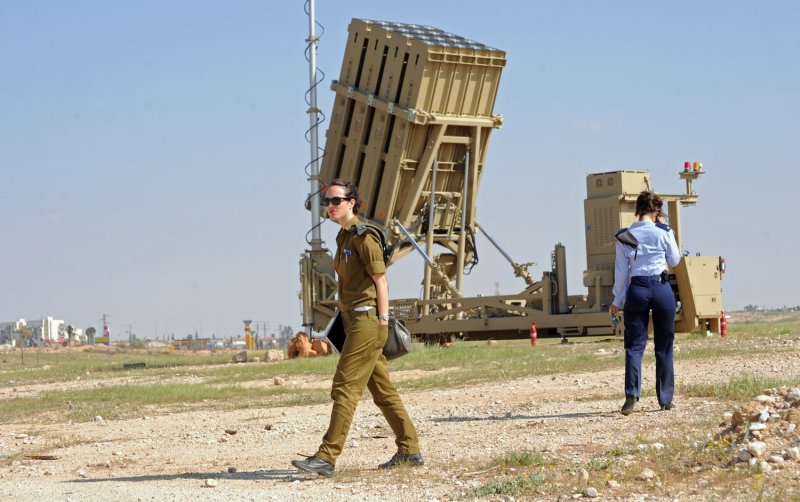Israeli soldiers stand near the Iron Dome, a new anti-rocket system, stationed near the southern city of Beersheba, Israel, March 27, 2011. The Israeli Defense Force deployed the $200 million Iron Dome system in response to dozens of rockets fired by Palestinian militants from Gaza in the past weeks. The Iron Dome is meant to protect Israeli towns from rockets fired from Gaza. UPI/Debbie Hill |
License Photo
TEL AVIV, Israel, June 29 (UPI) -- Israel's growing missile defenses will reportedly be integrated into the United States' planned regional defense network -- and could end up shielding Arab states that, in theory at least, are considered adversaries of the Jewish state.
Gen. Patrick O'Reilly, head of the Pentagon's Missile Defense Agency, told Defense News, a Washington weekly, that the multi-tiered Israeli system would strengthen the U.S. military's ability to protect its forces in the Middle East.
Israel is the only state with operational systems capable of intercepting rockets and missiles of different calibers and range.
Merging the two networks has actually been under way for some time.
Israel and U.S. forces have conducted several biennial Juniper Cobra joint exercises between the Israeli armed forces and the U.S. European Command to develop the interoperability of their air-defense systems.
In September 2008, Eurocom deployed a powerful Raytheon AN/TPY-2 X-band radar system to the Nevatim air base in the Negev Desert of southern Israel to bolster the Jewish state's air-defense capabilities.
The long-range X-band allows Israel's Arrow-2 anti-ballistic missile interceptor system, two batteries of which are currently operational, to engage Iranian Shehab-3b missiles about halfway through their 11-minute flight.
That's about six times faster than the Green Pine radar system used by Arrow.
Israeli commentators have argued that the U.S. effort to bolster Israel's air defenses is designed to discourage the country's political leadership from launching pre-emptive strikes against Iran's nuclear infrastructure to delay development of nuclear weapons.
If that is indeed the case, O'Reilly's disclosure of the integration of the two militaries' air-defense systems coincides with reports that Iran has accelerated its efforts to develop long-range missiles capable of hitting Israel and beyond.
Those reports were given added weight by Foreign Secretary William Hague of Britain Wednesday. He told Parliament in London that Tehran had conducted secret tests of ballistic missiles recently.
His gave no timeframe. But British sources claim Iran has carried out at least three tests with medium-range ballistic weapons since October amid other reports that it's also accelerating efforts to produce nuclear warheads.
Iranian forces are currently engaged in a 10-day program of maneuvers, codenamed Great Prophet 6, during which commanders claim they have test-fired liquid-fueled Shehabs.
They made no mention of the advanced and more accurate solid-fuel Sejjil-2 missile, which is the weapon that causes the most consternation in the West.
Gen. Amir Ali Hajizadeh, commander of the Islamic Revolutionary Guard Corps' strategic missiles forces, said Iran can produce intercontinental ballistic missiles but doesn't need to since it already has weapons that can reach Israel and U.S. military bases in the Persian Gulf.
These have ranges of up to 1,250 miles, enough to reach Israel and parts of southeastern Europe.
Western and Israeli intelligence services say Iran wants to produce intercontinental missiles with a range of up to 3,750 miles.
The Revolutionary Guards also unveiled what were identified as missile silos, facilities not seen in Iran before.
With regard to the planned integration of U.S. and Israeli missile defense systems, O'Reilly acknowledged this could mean Israeli batteries would be used to protect Arab states that are allies of the United States but which do not have diplomatic relations with the Jewish state.
Egypt and Jordan both have peace treaties with Israel, so it was not clear to which Arab states O'Reilly was referring. But it was mostly likely Saudi Arabia and its partners in the Persian Gulf, which at present are vulnerable to Iranian missile attack. Several host U.S. military bases that are within range of Iranian missiles.
Israel's multi-layered missile shield is still partly under development, although the high-altitude Arrow-2 system, jointly funded by the United States, has been in place since 2000.
A more powerful Arrow-3 variant capable of intercepting Iranian missiles outside Earth's atmosphere is being developed. It would be deployed alongside the Arrow-2s.
In March, the Iron Dome interceptor system, designed to counter short-range rockets and missiles, successfully made its combat debut in shooting down eight out of nine Grad-type rockets unleashed on southern Israel.
The fourth system, David's Sling, is still being developed and isn't likely to be operational before 2013. It's designed to counter medium-range missiles.
Israel's Defense Ministry says it plans to integrate all four systems, plus U.S.-supplied Patriots, into a national command center.





